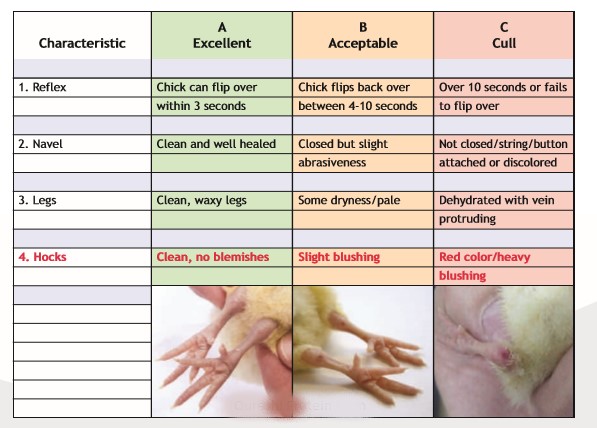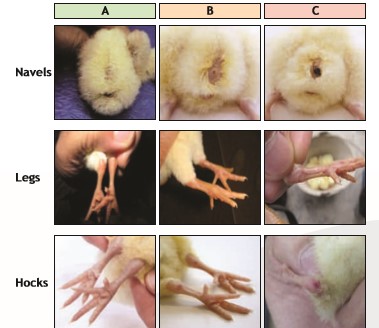Day old chick quality and grading is a very subjective area and the criteria can differ greatly, depending upon who you ask.
Hatchery manager - Wants as many chicks as possible – should be maximum number of grade A chicks.
Sexer – Prefers fresh chicks with enough meconium.
Broiler manager – Wants fresh chicks with good vitality, clean beaks and navels and low mortality levels.
Veterinarian - Wants chicks with good vitality and clean, well-healed navels.
There have been several chick quality monitoring systems or assessments developed over the years, but unfortunately they do not often correlate with 7-day mortality levels.
Below are typical characteristics identified in the hatchery for good quality chicks.
Traditional observations of chicks:
- Stand tall/upright , turn back on their fit after 3-4 second when placed on their back.
- Clear, bright eyes
- Clean, well-healed navel
- Good feather covering
- Colour – not pale chicks
- Few defects – toes, legs, beaks, etc
- Infection free – yolk sac, omphalitis
 |
 |
Below are some common areas where chick quality can be compromised and/or cause higher 7-day mortality levels.
Temperature:
- Too high/low or significant variations can influence
- Hatching times (too early/too late)
- Chick weights (absorption of the yolk)
- Hatchability levels
- Cull rates
- Incidence of ‘red beaks’
Humidity:
- Chick yield percentage and 7-day mortality
- Incidence of ‘red hocks’
- Navel quality
Chick Holding – This area is often underestimated. After spending 21 days to produce a good quality chick, it is easy to compromise chick quality with 30 minutes of adverse holding environments.
- Poor or inadequate ventilation or air movement, resulting in chicks overheating and panting.
- Lack of air volumes/movement (oxygen) causing listless and ‘flat’ chicks in the boxes.
- Too cold/draughts (over-ventilating) causing chicks to ‘huddle’ in the boxes.
- Boxes stacked too close together.
- Too many chicks in a box.
- ‘Dead spots’ in the room for air flow/circulation.
Chick Yield Percentage - The rule of thumb for incubation is that the chick should weigh two-thirds or 67% of egg weight. In antibiotic-free environments, there is clear correlation with adverse chick yields and 7-day mortality levels. This can also include the hatching times of chicks as they mostly coincide. Late hatching chicks (fresher chicks) have more residual yolk present and higher chick yield percentage, whereas earlier hatching chicks have absorbed more yolk and produce lower or normal chick yield percentage (66 to 68%). When more yolk is present, the chick is more susceptible to secondary infections from stress factors, leading to E. coli infections or bacillosis. As the chick consumes feed and water at the farm, the bacteria multiply resulting in high mortality levels from 2 or 3 days to 6 days of age.
